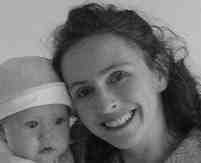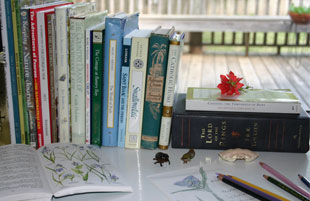| Author | |
TradCathMom
Forum Rookie


Joined: Feb 20 2005
Location: Wisconsin
Online Status: Offline
Posts: 94
|
| Posted: March 02 2005 at 8:32pm | IP Logged
|
 |
|
This month we are studying bees, yes, odd time of year for bees but last spring we had a swarm of bees land in a bush here, long story short, we are getting our honey now.... while the bees aren't stinging!  We have an extractor on it's way to preserve the honeycomb for more honey next year.... Anyway, any bee ideas? Crafts? books? I checked out many from the library but it's always nice to have suggestions that are tried and true! We have an extractor on it's way to preserve the honeycomb for more honey next year.... Anyway, any bee ideas? Crafts? books? I checked out many from the library but it's always nice to have suggestions that are tried and true!
Julie
__________________
Julie
 Wife to Tom Wife to Tom
Mother of 11
Julie's stuff
Trinity Acres
JMJ * AMDG
|
| Back to Top |



|
| |
JennGM
Forum Moderator


Joined: Feb 07 2005
Location: Virginia
Online Status: Offline
Posts: 17702
|
| Posted: March 02 2005 at 9:16pm | IP Logged
|
 |
|
I've got some ideas on how to incorporate the study of bees into religion class for Easter.  I posted some things under Alice's Easter Vigil Notebooks in the Domestic Church Forum. I posted some things under Alice's Easter Vigil Notebooks in the Domestic Church Forum.
JennGM wrote:
3. Study of Bees, Wax and Candles: This point is related to above. One phrase that is omitted in our current translation is the praise of the bees: In the grace of this night, then, O Father, receive for an evening sacrifice this burning light, which holy Church renders unto Thee at the hand of her ministers in the solemn offering of this candle of wax, wrought by bees. Now we know the glory of this column which God's bright flame kindles. Though divided into parts, yet it suffers no loss from the light which it imparts. For it is fed from the melted wax which the mother bee wrought for the substance of this precious lamp. The Church has a great affinity for bees and wax. I've given a few links to see the discussion regarding this.
- Where are the Bees? by Carol Zaleski
- Old Manuscripts for the Exultet, with illustrations praising the bees.
- 1915 article, The Paschal Candle, by Joseph May. History of the use of the Paschal Candle. Interesting note about the symbolism of the wax:
The pure wax," says a standard liturgical writer, "symbolizes Our Lord's humanity, which was stainless and sinless; and the light, His divinity, which always shone forth and illumined His every action." Early in the sixth century, Ennodius, Bishop of Pavia, gave three reasons why a wax candle should be used for religious purposes. First, because the rush wick, having come out of pure water, was an emblem of purity; secondly, because the wax, being produced by virgin bees, typified chastity (both bees and fish were regarded as sexless); and, thirdly, because the flame suggested the love that descended from heaven. Durandus likens the wax to the body of Christ, the wick to His soul, the flame to His divine nature, and the actual burning of the candle to His lingering passion and death. - The Wax Candle in the Liturgy by Fr. John Bolen, history of the liturgical use of candles.
- Address on Bees by Pope Pius XII.
- Blessing of Bees on the Feast of St. Benedict
- Blessing of Candles on Candlemas
Following the wax trail, the Church has required candles in the liturgy to be at least 51% beeswax. If you get a little bit of money, get a wonderful beeswax candle, to be closest to what the Church has. Williams-Sonoma was offering some nice ones, but I'm sure any liturgical store has some Church candles. You could also try to make your own...Martha Stewart has a "Candles 101" Beeswax burns cleaner, and seems to last longer, also less drips on your beautiful artwork. I was also looking at some candle decorating supplies from Hearthsong -- candle decorating waxes and pens that I thought would work wonderfully on decorating my own Paschal candle. |
|
|
__________________
Jennifer G. Miller
Wife to  & ds1 & ds1  '03 & ds2 '03 & ds2  '07 '07
Family in Feast and Feria
|
| Back to Top |



|
| |
TradCathMom
Forum Rookie


Joined: Feb 20 2005
Location: Wisconsin
Online Status: Offline
Posts: 94
|
| Posted: March 02 2005 at 9:34pm | IP Logged
|
 |
|
Thank you so much, I had never in a million years thought about that angle of bees. I would have missed that whole notebook post. I so much appreciate your directing me there. So Iguess it is a good time to study bees afterall! I wish I knew how to draw all these things together like the ladies here. I will learn, won't I?
Julie
__________________
Julie
 Wife to Tom Wife to Tom
Mother of 11
Julie's stuff
Trinity Acres
JMJ * AMDG
|
| Back to Top |



|
| |
JennGM
Forum Moderator


Joined: Feb 07 2005
Location: Virginia
Online Status: Offline
Posts: 17702
|
| Posted: March 02 2005 at 9:36pm | IP Logged
|
 |
|
I'm hoping I'll learn, too! Everyone constantly amazes me! 
__________________
Jennifer G. Miller
Wife to  & ds1 & ds1  '03 & ds2 '03 & ds2  '07 '07
Family in Feast and Feria
|
| Back to Top |



|
| |
Molly Smith
Forum All-Star

Joined: Feb 08 2005
Location: Virginia
Online Status: Offline
Posts: 669
|
| Posted: March 03 2005 at 5:11am | IP Logged
|
 |
|
I'll just share two quick things we learned about bees on a field trip with a beekeeper last fall. First is that skunks are big culprit for getting into the bee boxes, but they are unaffected by bee stings except on their bellies. That's why beekeepers keep their bee boxes up high--when the skunk goes up on its hind legs to reach the boxes, its belly is exposed and gets stung. Second it that bears don't actually get into the hives for the honey--they are actually going for the baby bees. Yuk.
Fun facts to know and tell...
__________________
Molly Smith in VA
Mom to seven beautiful children, ages 1-14
|
| Back to Top |


|
| |
Angie Mc
Board Moderator


Joined: Jan 31 2005
Location: Arizona
Online Status: Offline
Posts: 11400
|
| Posted: March 03 2005 at 8:36am | IP Logged
|
 |
|
TradCathMom wrote:
I wish I knew how to draw all these things together like the ladies here. I will learn, won't I?
Julie |
|
|
It appears to me that you are pulling things together in beautful ways already, Julie! When I hear a mom talking about her bees and all the cool stuff she plans to do around bees, I think to myself..."I wish I was doing that!" For me, it is just easier to be wowed by the things others are pulling together. My stuff and the "relation" our family has with our stuff seems simple/natural while I am awed by the connections others make. It truly is inspiring, isn't it!
Thanks for contributing here!
Love,
__________________
Angie Mc
Maimeo to Henry! Dave's wife, mom to Mrs. Devin+Michael Pope, Aiden 20,Ian 17,John Paul 11,Catherine (heaven 6/07)
About Me
|
| Back to Top |



|
| |
MaryM
Board Moderator


Joined: Feb 11 2005
Location: Colorado
Online Status: Offline
Posts: 13104
|
| Posted: March 04 2005 at 1:07am | IP Logged
|
 |
|
"To make a prairie it takes a clover and one bee." - Emily Dickinson
Bees are so much fun to study! Jenn's info on the candles in the faith forum did make a nice fit here. When you asked about ideas one of the first things I thought of was that spiritual connection as well. A study of St. Ambrose, who is often pictured with bees (patron of candlemakers and beekeepers) would be a great addition. I hadn't known he was the patron of beekeepers until we visited a beekeeper last fall to watch the extraction process and saw several pictures of St. Ambrose on the wall.
I don't know which books you got at the library so possibly some duplicates here.
General Bee Books-nonfiction
The Life and Times of the Honeybee-very informative and great illustrations
The Honey Makers
Dragonfly, Beetle, Butterfly, Bee- gorgeous drawings, really helpful for nature study and sketching
Picture Books
The Bee Tree by Patricia Polacco - I always enjoy her books
Honeybee and the Robber by Eric Carle (from what you shared above Julie, I don't think Carle really got it right about the bears though)
Beekeepers-about the work of a beekeeper
The Beeman-cute book
When the Bees Fly Home- I haven't read this one yet,but it looks interesting.
Fiction
Boxcar Children have a book called The Boxcar Children and the Honeybee Mystery. It's one of the newer Boxcar Children books (published after the original authors death) which I don't necessarily like as well as the originals, but it sounds interesting.
American Girl Collection - Kirsten Saves the Day: A Summer Story about Kirsten's attempt to retrieve honey from a bee tree on her own.
Bee Music
Nicolai Andrejevich Rimsky-Korsakov's Flight of the Bumble Bee. Very fun to listen to - one can almost see the bees in flight.
Math and patterns
Are you familiar with Zome? They are a great construction toy that is especially suited to teaching about mathematical and scientific patterns. If you have the Zome sets you can use these lesson plans from their teacher's guide. It has a couple activities for discussing the patterns found in the honeycombs.
Here is an elementary lesson Zome lesson 1
Here is a more advanced lesson Zome lesson 2
They also sell a kit specific to study of the bees which I think does the same types of lessons.
Wonders of Nature kit
Crafts
A couple fun ideas from Family Fun magazine.
Bee decorated egg
Cupcake (it's supposed to be a wasp, but who will know?)
Arty Facts Insects, Bugs and Art Activities has a neat honeycomb you can build out of posterboard.
Misc.
-Compare and contrast bees with yellow jackets/hornets/wasps. We had a huge scary looking hornet's nest on the side of our house last year. Waited till winter, sprayed and took it down. Very fascinating to look inside.
-See through the eyes of a honey bee
Dances with Bees - this is fun to watch and learn about how bees communicate. It's on the NOVA page. I've never seen the special they talk about "Tales from the Hive" but I'm going to look for it.
Find out why Utah is nicknamed the Beehive State? (that one is for you, Elizabeth)
__________________
Mary M. in Denver
Our Domestic Church
|
| Back to Top |



|
| |
alicegunther
Forum All-Star


Joined: Jan 28 2005
Location: N/A
Online Status: Offline
Posts: 1992
|
| Posted: March 04 2005 at 5:09am | IP Logged
|
 |
|
Wow, Mary, what incredible ideas. I will be keeping this post to use as reference in the future. Thanks!
__________________
Love, Alice
mother of seven!
      
Cottage Blessings
Brew yourself a cup of tea, and come for a visit!
|
| Back to Top |



|
| |
MacBeth
Forum All-Star


Probably at the beach...
Joined: Jan 27 2005
Location: New York
Online Status: Offline
Posts: 2518
|
| Posted: March 04 2005 at 11:06am | IP Logged
|
 |
|
alicegunther wrote:
| Wow, Mary, what incredible ideas. I will be keeping this post to use as reference in the future. Thanks! |
|
|
Um...Alice, don't you think that a bee study is not really for you, given a certain child's sweet attractiveness to stinging insects?

Great list, Mary! My cousin keeps bees, and it's such an exciting visit every time we go there. Now we can add more books!
__________________
God Bless!
MacBeth in NY
Don's wife since '88; "Mom" to the Fab 4
Nature Study
MacBeth's Blog 
|
| Back to Top |



|
| |
JennGM
Forum Moderator


Joined: Feb 07 2005
Location: Virginia
Online Status: Offline
Posts: 17702
|
| Posted: March 04 2005 at 11:27am | IP Logged
|
 |
|
MaryM wrote:
A study of St. Ambrose, who is often pictured with bees (patron of candlemakers and beekeepers) would be a great addition. I hadn't known he was the patron of beekeepers until we visited a beekeeper last fall to watch the extraction process and saw several pictures of St. Ambrose on the wall.
|
|
|
St. Ambrose's connection with bees comes from his nickname being "honey-tongued doctor".
Some info on St. Ambrose: Celebrating for the Feast of St. Ambrose
December 7, Feast of St. Ambrose
I have always wanted to do the beekeeping! It's so fascinating. What a great oppportunity for your children to have it right there to study.
Another tangent: I always think of the following quote when I think of beekeeping. Janet Kalven, Woman and Post-War Reconstruction . Although this touches on the rural homestead, it explains the nature of woman and explains to me why the mother is so successful at this type of "Real Learning." I've highlighted in red my points. (NOTE: Ms. Kalven went off the deep-end after Vat II and tried to destroy all her previous work, so don't think that this quote means I recommend all her writings!) Rural Homesteads
How will woman’s influence affect the agricultural pattern? What form of life on the land will appeal to women and attract them to the rural areas? The new pattern of life on the land must meet the fundamental requirements of woman’s nature if it is to win her enthusiastic interest and active support. It must provide the conditions to family and community. Only then can we have a really healthy and well-balanced rural life.
What are the conditions which woman’s nature requires on the land? First of all, the woman needs the small, diversified, family farm. The homestead, producing primarily for family use and only incidentally for sale should become the basic unit of the new agricultural pattern. The ideal of practical self-sufficiency can be realized on much smaller farms than are customary today, although the exact acreage will vary with local conditions. Because it is family-centered, organized first of all to supply all that the family requires for a full life, the homestead is deeply satisfying to woman’s nature, for she is a universality and a personalist. She is made to be everything to somebody, some person. That is why the large commercial farm with its hundred cows or thousand acres of wheat has little interest in her. These are specialist ventures, which usually make her a specialist in the kitchen just as they make her husband a specialist with milking machines or combines. But the small, diversified farm corresponds completely to her desire for variety and personalized relationships in work. She enjoys the homestead with its few cows to furnish butter, milk and cheese for her family; its few pigs for meat; its few sheep for lamb and wool; its small flock of chickens for really fresh eggs; a few bee hives for honey; perhaps a flock of ducks to add a note of color and humor to the farm yard. She wants to plant an orchard, a vineyard, a berry patch, an herb and flower garden, as well as a plot of vegetables. She is by nature of Jill of all trades, as Chesterton puts it, and finds relaxation in turning from her household tasks to weed the garden or milk the cow. She wants to know the animals individually, to give them names, even to make pets of them. On the family homestead, the birth of every calf is an event anxiously awaited by the entire family. Everyone knows the peculiarities of each animal, and this knowledge itself adds interest to the work. The homestead is on a human scale, giving rich possibilities for satisfying activity for every member of the family. If women think that agriculture means commercial farming with its crushing burden of specialized, impersonal work, they will take no interest in it and want no share in it. But if they see that the rural life movement means the small, diversified, family-centered farm, they will turn toward it enthusiastically and join the ranks of those who are moving forward to the land.
I have another quote that is similar...if I could ever get my scanner back up!
BTW, how does one know if they are allergic to beestings if they have never been stung 
__________________
Jennifer G. Miller
Wife to  & ds1 & ds1  '03 & ds2 '03 & ds2  '07 '07
Family in Feast and Feria
|
| Back to Top |



|
| |
alicegunther
Forum All-Star


Joined: Jan 28 2005
Location: N/A
Online Status: Offline
Posts: 1992
|
| Posted: March 04 2005 at 5:06pm | IP Logged
|
 |
|
MacBeth wrote:
alicegunther wrote:
| Wow, Mary, what incredible ideas. I will be keeping this post to use as reference in the future. Thanks! |
|
|
Um...Alice, don't you think that a bee study is not really for you, given a certain child's sweet attractiveness to stinging insects?

|
|
|
LOL, MacBeth, you are quite right!!!
As MacBeth well knows, my seven year old seems to attract bees, not to mention wasps. She gets stung at least three times every summer and is understandably terrified of anything with a stinger.
I recently toyed with the idea of purchasing a bee skep at a local garden supply store, but my sting-prone daughter informed me it was out of the question. If any of you are eager to attract bees in your yard, you might want to consider purchasing a bee skep. They appear not only useful and interesting, but decorative as well. I would be interested to hear from anyone with first hand knowledge of how well they work.
__________________
Love, Alice
mother of seven!
      
Cottage Blessings
Brew yourself a cup of tea, and come for a visit!
|
| Back to Top |



|
| |
Karen T
Forum All-Star


Joined: Feb 16 2005
Online Status: Offline
Posts: 927
|
| Posted: March 04 2005 at 10:53pm | IP Logged
|
 |
|
Molly Smith wrote:
Second it that bears don't actually get into the hives for the honey--they are actually going for the baby bees. Yuk.
Fun facts to know and tell... |
|
|
I had always wondered about this, since bears primarily eat grubs, berries, fish, etc. I couldn't figure out why honey would be a part of their diet, since they don't need a lot of "quick energy" which honey provides (simple sugar); they need more protein and fat. So this makes perfect sense!
On a side note, I have a way cool bear paw plaster print. It's from a black bear, taken near Stone Mountain Park which is very close to me. I didn't make it, but a friend did and gave it to me. That foot looks BIG to me, and black bears aren't even one of the larger bears!
karen T
|
| Back to Top |


|
| |
|
|


 Topic: Bees
Topic: Bees


 We have an extractor on it's way to preserve the honeycomb for more honey next year.... Anyway, any bee ideas? Crafts? books? I checked out many from the library but it's always nice to have suggestions that are tried and true!
We have an extractor on it's way to preserve the honeycomb for more honey next year.... Anyway, any bee ideas? Crafts? books? I checked out many from the library but it's always nice to have suggestions that are tried and true!
 Wife to Tom
Wife to Tom



 I posted some things under Alice's
I posted some things under Alice's  & ds1
& ds1  '03 & ds2
'03 & ds2  '07
'07














